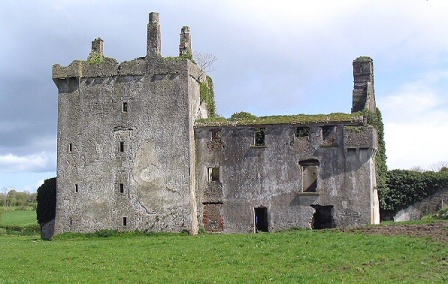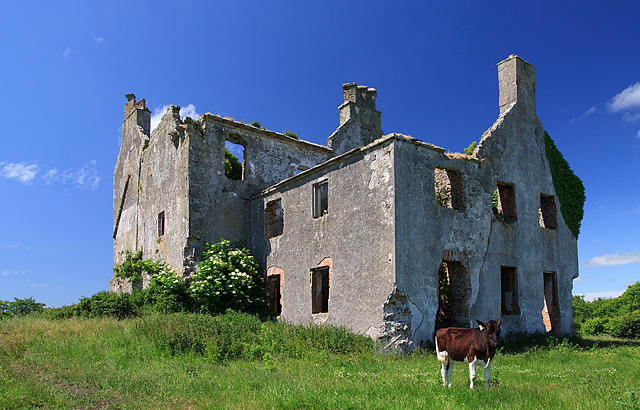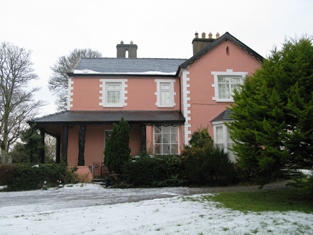Glenmore
Houses within 10km of this house
Displaying 25 houses.
Houses within 10km of Glenmore
Displaying 25 houses.
| House name | Description | |
|---|---|---|
| Deel Castle | James Cuff, Lord Tyrawley, built a house beside the Old Bourke Castle in 1791. It is labelled Deel Castle on 1st edition Ordnance survey map but as Castle Gore on the later 25-inch edition The house was burnt in 1922 and not rebuilt. |

|
| Ballintober | At the time of Griffith's Valuation, this property was held in fee by Nicholas Handy and valued at £8. The house is no longer extant but it was positioned behind the present house, where the red corrugated roofed building now stands. |

|
| Farmhill | Built in 1780 this house became the principal seat of the Gardiner family. It was left by Harriet Gardiner to Susan Pringle who died in 1910. Farmhill then became the parochial house until the 1950s when it was demolished. Only the large walled garden now remains. | |
| Tonroe | Another Gardiner house in the parish of Rathreagh. At the time of the Ordnance Survey in the 1830s it was described as being in bad repair and occupied by a herd. P Ruane described the dilapidated state of the house in the mid 1990s but writes that the setting was very attractive. | |
| Courthill | The house was built in 1768. In 1786 Wilson refers to "Ranadyff" which may be this property, as a seat of Mr. Gardiner. At the time of Griffith's Valuation the occupier was Lacklin Chisholm. Frank Boland had a racing stable at Courthill in the 1940s and trained a horse named 'Lough Conn', who came second in the Aintree Grand National of 1947. |

|
| Springhill | Springhill was occupied by Francis Goodwin in 1814 and by Thomas Goodwin in 1837. By the time of Griffith's Valuation Bartholomew Donohoe was leasing the townland from the Palmer estate but the buildings were only valued at 10s. Springhill is labelled as "in ruins on the 25-inch map of the 1890s and there is no trace of it now. | |
| Castle Gore | The old Bourke Castle on the river Deel was granted to the Gores at the end of 17th century. They added a large wing to the old castle in the 18th century and renamed it Castle Gore. The castle along with other lands was leased to James Cuff, Lord Tyrawley towards the end of the 18th century. Wilson refers to it as "the pleasant old seat of the Earl of Arran, now occupied by Rt. Hon. James Cuffe" in 1786. Occupied by the Cuff's steward for part of the 19th century. At the time of Griffith's Valuation it was occupied by Captain St. George Cuffe and valued at £60. In 1894 Slater refers to it as a seat of the Earls of Arran though this may refer to the late eighteenth century house nearby. |

|
| Fortland | The Jacksons held this property from the Pratts of Enniscoe. It was described in the 1830s as a plain house ornamented with a few trees and scrubs. At the time of Griffith's Valuation it was leased by George H. Jackson from Mervyn Pratt when it was valued at £12. It is still extant ad now owned by Billy Cook. |

|
| Enniscoe House | The site of an old Bourke castle on the shore of Lough Conn, the house was built before 1786 as Wilson refers to Prospect as the seat of Mr. Jackson at that time. It was held in fee by Mervyn Pratt at the time of Griffith's Valuation, when it was valued at £50. It appears as Inishcoe House on both the 1st and 25-inch ediitons Ordnance Survey maps but is now known as Enniscoe House. The North Mayo Family History centre is based in adjacent buildings and the house offers guest acommodation. |

|
| Rappa Castle | An old Bourke castle, granted to a Cromwellian soldier named Crofton. It passed into Knox ownership through marriage and was the seat of this influential branch of the Knox family throughout the 18th and 19th centuries. In 1786 Wilson refers to it as "the pleasant seat of Mr. Knox". At the time of Griffith's Valuation it was held in fee by Annesley Knox and valued at £30. Slater notes it as the seat of Captain Annesley Knox in 1894. Occupied by the Knox family until the early 20th century, the house is now a ruin. |

|
| Netley House | The home of Henry William Knox, fourth son of Francis Knox of Rappa, occupied by Richard Burke at the time of Griffith's Valuation when the house was valued at £30.. The house is now a ruin. |

|
| Greenwoodpark | Built in 1814, the home of Major John Knox, sixth son of Francis Knox of Rappa and sold by his daughter Florence to her cousin, a Knox of Mount Falcon. The Armitages lived at Greenwoodpark in the 20th century but the house is now a ruin. |

|
| Knockglass House/Woodville | Also known as Knockglass House, this residence was situated close to the demesne of Greenwoodpark. At the time of Griffith's Valuation it was leased by John McDonnell from Major Knox when it was valued at £6. It is labelled Knockglass House on the 1st edition Ordnance Survey map but appears to be in ruins by the publication of the 25-inch edition map in the 1890s. | |
| Owenmore or Millbrook | Ordnance Survey Field Name Books record a 'neat cottage' in the townland of Correens, built in 1796 and called Millbrook. Irish Tourist Association File records Owenmore as the residence of the Misses Knox in 1942, erected about 1830 by the Orme family. The house belonged to the McCausland family in the latter part of the 20th century. Now owned by Gerry O'Mara. |

|
| Belville | An Orme home in the first half of the 19th century. Described in 1942 by the Irish Tourist Association surveyor as a large house near the church at Ballyglass, formerly owned by the Orme family and "purchased some years ago by Mr MacDonald, Kilfian. It has remained unoccupied...", due to a popular belief among the local people that the house was haunted. It is no longer extant. | |
| Abbeytown | The original historical abbey buildings in this townland are described as 'in ruins' at the time of the first Ordnance Survey. It was formerly the residence of a Mr Crofton but was then occupied by a caretaker for the Orme family. Abbeytown House is shown a litte to the north on the later 25-inch map of the 1890s. The property was bought by Anthony Carolan of Crossmolina at the sale in 1852 and the house was later lived in by the parish priest. Abbeytown is still extant and occupied. |

|
| Ballycarroon | A house dating from the early 19th century. At the time of Griffith's Valuation it was occupied by Isadore Andrew Lynch, who sub leased it from Henry Charlton. Later occupied by members of the Craven and Connor families. A house still exists at the site. | |
| Gortnaraby/Gortnor Abbey | Ruane dates this house to the mid 18th century.In 1786 Wilson refers to it as the seat of Mr. Ormsby. At the time of Griffith's Valuation, it was leased from John Ormsby by an individual named Connop and valued at £25. In 1916 it was taken over by the Order of Jesus and Mary and now functions as a secondary school. |

|
| Knockglass | The main residence of the Paget family in the 19th century. Afterwards it passed into the possession of Patrick Rowe and later served as the home of the Church of Ireland Bishop of Tuam, Achonry and Killala. In 2011 it was offered for sale. |

|
| Fahy | Built 1796, a former Paget home occupied by Ernest Knox of the Castlereagh family in the late 1830s. Lackland Chisholm was the tenant at Fahy in 1853. The original house is no longer extant. | |
| Ballybroony | An 18th century house, occupied by Fallon in the late 1770s and in 1786. The residence of the Perkins family from the early 19th century. It was held by Arthur Perkins from the Earl of Arran at the time of Griffith's Valuation when it was valued at £17. Lived in until the early 21st century and for sale in 2006. Restoration work was underway in 2010. |

|
| Smithstown House | Ruane writes that the house was built by the Palmers and became a Royal Irish Constabulary barracks. It was the home of the Pugh family in the 1830s. The only building in the townland at the time of Griffith's Valuation, of more than £2 valuation, was the barracks. Sold in 1988 and now the home of Mrs Loretta Clarke Murray and family. |

|
| Farragh | An 18th century house on the Palmer estate. Wilson refers to it as a residence of Mr. Palmer in 1786. Leased to the Waldrons in the early 19th century and occupied by Hector Sutherland at the time of Griffith's Valuation when the house was valued at almost £8. The original building is no longer extant. | |
| Lodge | There is no suitable building named in this townland on the first edition of the Ordnance Survey map. A shooting lodge is, however, shown on the 25-inch Ordnance Survey map of the 1890s. This building is no longer extant. | |
| Mullenmore | In 1786, Wilson refers to Mullennore as the seat of Mr. Cormack, "pleasantly situated on the edge of Lough Conn". The townland was in the ownership of the Palmer estate at the time of Griffith's Valuation and there was no substantial house there. |

